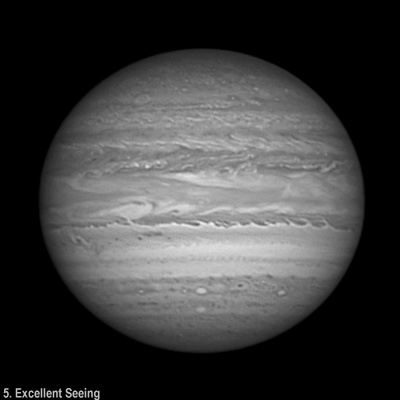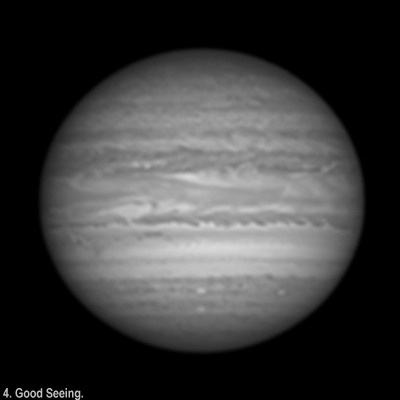

A Modern Scale of Astronomical Seeing for Imagers.
By Damian Peach.
Introduction.
Astronomical seeing scales such as those of Antoniadi and Pickering are well known to visual observers though for modern Planetary imagers using CCDs and webcams they aren't especially convenient to use since the vast majority of the time such observers are watching the Planetary image on screen.
Having many years of experience in Planetary imaging and having taken thousands of video sequences i have selected five sequences by which observers can gauge the prevailing seeing conditions. I decided Jupiter as the object for references as it is probably the most popular target among Planetary imagers. All example videos were taken with my C14 Telescope and SKYnyx camera. All captures were taken through a Green Light filter. A five point scale was decided upon comprising the following:
5. Excellent Seeing - A solid stable disk with good contrast. Minor Planetary details are held for long periods. No significant undulation or fuzziness.
4. Good Seeing - A mostly solid stable disk with good contrast. Minor details are frequently seen though not held for long periods.
3. Fair Seeing - Slight or moderate undulation or fuzziness. Reasonable contrast. Minor planetary details occasionally seen.
2. Poor - Very Poor seeing - Severe undulations or fuzziness. Poor contrast. Large scale detail poorly defined. Minor details invisible.
1. Extremely Poor seeing - Severe undulations or fuzziness. Very poor contrast. Little detail visible.
Rather than adding additional points into the scale, if seeing falls between two of the values, then it should be rated good to excellent or fair to good etc.
Presented below are six example video clips from my observational archive illustrating this five point scale.

5. Excellent Seeing Conditions.
A solid stable disk with good contrast. Minor Planetary details are held for long periods. No significant undulation or fuzziness.

4. Good Seeing Conditions.
A mostly solid stable disk with good contrast. Minor details are frequently seen though not held for long periods.

3. Fair Seeing Conditions.
Significant fuzziness or undulation. Fair contrast. Larger scale detail well seen. Minor details mostly invisible.

2. Poor - Very Poor Seeing conditions.
Severe undulations or fuzziness. Poor contrast. Large scale detail poorly defined. Minor details invisible.

1. Extremely Poor Seeing Conditions.
Severe undulations or fuzziness. Very poor contrast. Little detail visible.
Copyright © 2003-2004. www.damianpeach.com. No material used within this website may be used, amended or distributed without the consent of the webmaster.